
When trout show up this month, the Wando and Cooper rivers are two places you should be looking.
Roughly the same size as a golf ball, you’d think a popping cork would be easier to keep up with. After all, it’s fluorescent orange and has a string tied to it. But try as he might, the fisherman perched in the front of John Ward’s flats boat lost track of the thing.
In his mind, he ran through the “lost keys” scenario. He had been casting the rig, complete with plastic shrimp, along a stretch of grassy shoreline near the mouth of Clouter Creek. After each cast, he had dutifully popped the cork with just enough force to make the beads clack and create a small swirl near the grass. On the last cast, the cork had landed squarely in front of a small opening in the grass where high tide was leaving in a small rivulet. He had looked away absently after making the first resounding “pop” when a passing shorebird had caught his attention. Now, looking back, he’d lost track of the darn thing.
“Set the hook,” Ward coached, watching from the rear deck, where he’d seen current flowing out of a small ditch and decided it looked like a good ambush spot for a trout.
With a resounding “Oh yeah,” realization of what had happened to the cork, the fisherman dutifully swept back with the rod tip and connected with the fish. A fight ensued, with the fish making a beeline for open water. After reaching the end of the line in that direction, the fish banked, and after two shorter runs was guided straight into the waiting landing net.
Ward congratulated his guest, dislodged the hook from the fish’s mouth. “Throw back in that same spot,” he offered. “Where there’s one, there’s probably more.”
Such was the beginning of another March day on the Cooper River, which, along with the Wando River, provides some of the Charleston area’s best spring fishing.
According to Ward, a James Island resident who operates Affinity Charters, the first few days of March find speckled trout in the Cooper River, holding in tightly-bunched schools in relatively deep water.
“We’re not talking about 60 feet, which can be found in the Cooper, but they do tend to hole up in 12- to 15-foot holes around the mouths of feeder creeks and in scoured out depressions along the channel,” Ward said. “That’s not terribly deep, but with low water temperatures, the trout are extremely dormant, and it’s tough to catch them until the temps come up a little.”
Ward looks for the trout bite to turn on when water temperatures reach the lower 60’s. Some years, that comes early in the month, and some years, it arrives later.
“Last year, we had a mild winter, and we hit mid-60s by the middle of the month,” he said. “Then, we had some late cold fronts, and it bounced the trout back to deeper water, but for two weeks in March, we had some outstanding action.”
Given the cold winter of early 2010, Ward looks for the trout to stay in deeper water most of the month unless there’s a lot of warm, sunny weather on tap.
“We fish the deeper holes with light line, 6-pound test, and use smaller, soft plastics that either emit their own scent or with scent sprayed on,” he said. “Then, it’s a matter of casting across the breaks and bringing the bait back slowly across the drop, trying to mimic a baitfish that’s been washed into the hole.
“I’ve also found that a few bigger trout will school up with redfish pods, because we’ve caught some good trout while casting to redfish.”
Once the magic water-temperature number is achieved, Ward’s game plan revolves around more typical trout tactics of plastic baits fished under a popping cork.
“If you’re not familiar with likely fishing spots, the best thing to do is ride around the area at low tide and make note of structure such as oyster piles, abandoned pilings, and drainage ditches,” he said. “There’s a lot of those ditches both along the Cooper and in Clouter Creek, which is the biggest tributary between the I-526 bridge and Charleston Harbor.”
Ward prefers to fish the entire outgoing tide cycle and finds the bite is better right after the tide begins heading out; that’s typically when feeding begins. With water still in the edges of the grass and covering oyster piles, he may cast a topwater or shallow-diving plug early on, and then bring out the popping cork to suspend his baits over structure when the water levels start dropping off.
“What little bait there is in the grass this early in the season will pull out with the outgoing tide,” Ward said. “The trout bite will usually turn on as the water starts to move out, and some days it may last the entire outgoing tide.”
Along with the first couple of miles back from the mouth of Clouter Creek, Ward will also fish Yellow House Creek, located above the I-526 bridge. He also advises anglers not to overlook structure along the main banks of the Cooper, such as the rip-rap walls on the Daniel Island side of the river, the old bend at the coal trestle and the industrial docks on the west bank.
Looking at the playbook of Capt. Johnny Spitzmiller of Ambush Inshore Charters, the speckled-trout version of March Madness on the Wando River begins when water temperatures break the mid-50s. Spitzmiller, from Mount Pleasant, starts looking for specks hanging around the deeper ends of boat docks and long points that jut out into the river. Like Ward, Spitzmiller often locates early season trout holding in deep holes early in the month, but he has a tough time getting the lethargic fish to bite.
“Trout are not as aggressive now as they will be later in the spring,” said Spitzmiller. “Because they’ll be in a little deeper water, you almost have to use your anchor to position your boat to fish the points and docks. I try to drift into position quietly and lower the anchor and get set without making a lot of racket. I even wrap my anchor chain in duct tape to minimize the noise.”
Rather than using a popping cork to attract attention to his bait, Spitzmiller prefers to cast a weighted plastic bait — typically a DOA Shrimp — upcurrent and slowly reel the bait back to him, keeping it just off the bottom. Light line and light tackle are the order of the day.
“I try to keep my rod tip up in the 10 o’clock position, ready to set the hook at the slightest strike,” he said. “Often, the trout will nail the bait with that canine tooth, and then come back and eat it.”
Spitzmiller divides his trout-fishing efforts according to water temperature. Before the water temperature hits the 55-degree mark, he’ll fish the deeper areas west of the SC 41 bridge for eight to 10 miles to where the Wando meets the Cooper. Beresford’s Creek and Horlbeck Creek are two major tributaries that will often hold deepwater fish.
Above 55 degrees, he relocates to the east side of SC 41. Spitzmiller prefers the deeper boat docks around the Dunes West community and several of the smaller creek drainages that empty into the river between the bridge and Paradise Landing.
“The great thing about this area is that you can fish the whole thing in half a day, and you don’t have to have a big boat — a 14- to 16-foot boat will work fine — and there’s a lot of fish to be caught in there.”
Spitzmiller often elects to go with the cork in the warmer water, but he still has a preference for casting a weighted bait only and easing it around structure to coerce rod-bending action.


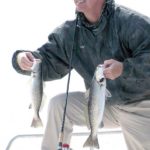
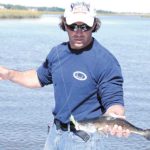
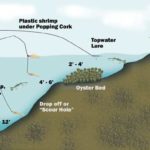
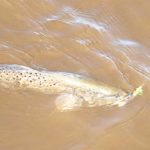
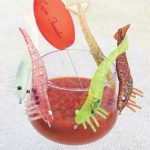
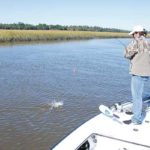



Be the first to comment